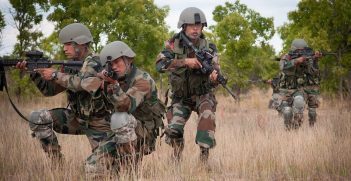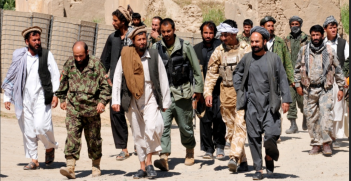Reading Room: My Enemy’s Enemy—India in Afghanistan

One of the key lessons of Kautilya’s great manual of statecraft, the Arthashastra, is that the effective management of an adversary often involves allying with one’s enemy’s enemies. But as Avinash Paliwal’s rich and readable book shows, this is easier said than done.
Drawing on extensive interviews with officials and others in Afghanistan and India, My Enemy’s Enemy traces the ups and significant downs in a bilateral relationship deeply coloured by their interactions with their mutual neighbour, Pakistan. The story it tells of India’s ‘policy flux’ over the last three decades is convoluted and, at times, somewhat dispiriting. New Delhi dabbles in Afghanistan’s fractious politics and internal conflicts, gets caught flat-footed, pivots, doubles back and, it seems, loses out as often as it succeeds. India has no choice but to be involved in Afghanistan, given its location, its historic ties and its strategic interests. Yet at the same time, if it engages too deeply and becomes too far embroiled, it runs the risk of incurring significant costs to its citizens and its concerns.
Paliwal divides the book into three parts. The first provides necessary background: a brief history of bilateral relations up to the end of the Soviet military action in Afghanistan, with a particular emphasis on New Delhi’s interest in the fate of the Baloch and Pashtun peoples on both sides of the Afghan-Pakistan border and its struggle to manage the challenges posed by Moscow’s intervention. It includes clear-sighted accounts of Indira Gandhi’s tortuous attempt to maintain the fiction of nonalignment while ‘tilting’ to the Soviets and of Rajiv Gandhi’s deepening of ties with doomed Afghan President Mohammed Najibullah.
The second part deals with India’s approach to the rise of the Taliban and the aftermath of 9/11. After Najibullah fell, in the very different global context of 1992, New Delhi moved relatively swiftly to engage the new Mujahideen-run government and the various Mujahideen groups. However, the Indian government was unable to anticipate the distinctive character of the Taliban, which emerged and rapidly grew in power from late 1994 onwards, and failed to engage them as a player in Afghan politics. Instead, by the time Kabul fell to this new force in September 1996, New Delhi found itself trying to ‘contain’ it, to use Paliwal’s term, with diplomatic, financial and material support for the anti-Taliban United Front. Whether this more robust approach paid dividends is a moot point. Paliwal argues that, right or wrong, India was “unsuccessful in shaping the practical course of actions after the fall of Kabul”. It lost touch with influential Pashtuns too, viewing the Taliban as a Pakistan-, or at least Inter-Services Intelligence (ISI)-created jihadi proxy, rather than an agglomeration of different interests, some less sympathetic to Islamabad and Rawalpindi than others.
The final part turns to New Delhi’s engagement of the Hamid Karzai government and its partial re-engagement with the Pashtuns, including its subsequent shift to a more nuanced stance towards the Taliban. It also discusses India’s increasingly active—and partially successful—handling of the intricate multilateral diplomacy that foreshadowed and then paralleled NATO’s exit from Afghanistan. It suggests that New Delhi won more than it lost in this phase, as it sought to draw and keep other stakeholders involved, including China, Iran and Russia, as well as the United States, to balance or at least mitigate the worst excesses of Pakistan’s influence.
Paliwal seeks to make sense of these varying Indian approaches, which are described in meticulous detail, by seeing them as the product of tussles between ‘conciliators’ and ‘partisans’ within the Indian policymaking elite. The first group, he suggests, advocate engagement with all parties as the best means to manage the bilateral relationship between India and Afghanistan; the second push for stronger ties with forces opposed to Pakistan, its proxies and its allies. This schema has advantages, not least in liberating Paliwal from having to shoehorn particular policy positions into artificial academic categories. But it still would have been interesting to dig a bit deeper, in both the interviews and in the analysis, to see the extent to which policymakers favour conciliation or partisanship because of prior beliefs concerning their understanding of how politics and international relations work in general and in South Asia in particular.
My Enemy’s Enemy is nonetheless a very impressive achievement: an exquisitely detailed account of the twists and turns of this important relationship. The material gathered from interviews in Afghanistan and India (and beyond) is eye-opening, in parts, and the book as a whole is an excellent demonstration of how contemporary history can be written in the absence of official records.
Avinash Paliwal, My Enemy’s Enemy: India in Afghanistan from the Soviet Invasion to the US Withdrawal (London: C. Hurst & Co., 2017). ISBN: 978-1-84904-834-7.
Professor Ian Hall teaches in the School of Government and International Relations, Griffith University. He is a member of the Griffith Asia Institute and an Academic Fellow of the Australia India Institute. Dr Hall and his Griffith University colleague Dr Sara Davies have been appointed the new editors of the Australian Journal of International Affairs, which is published by the AIIA.
This article is published under a Creative Commons Licence and may be republished with attribution.





